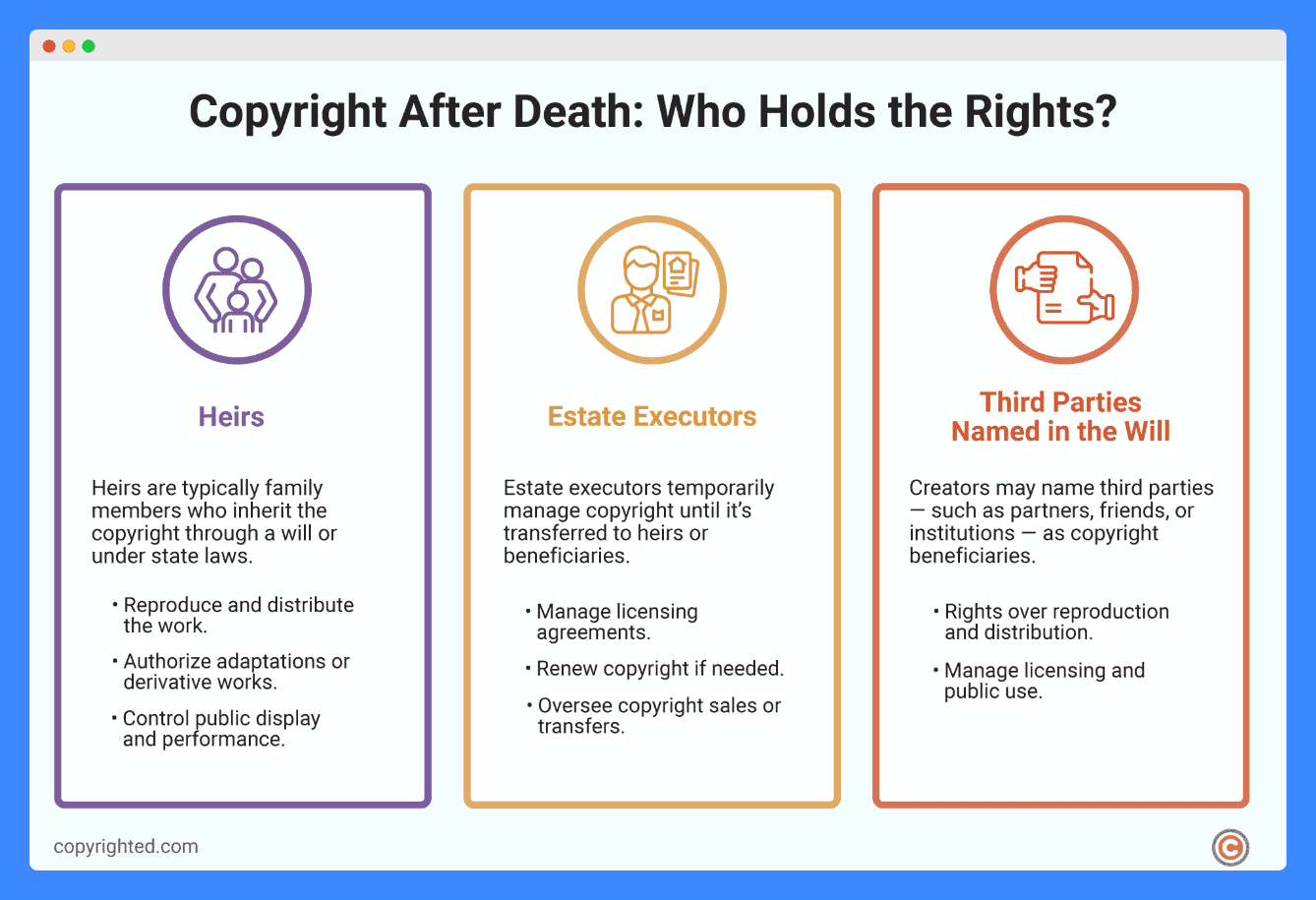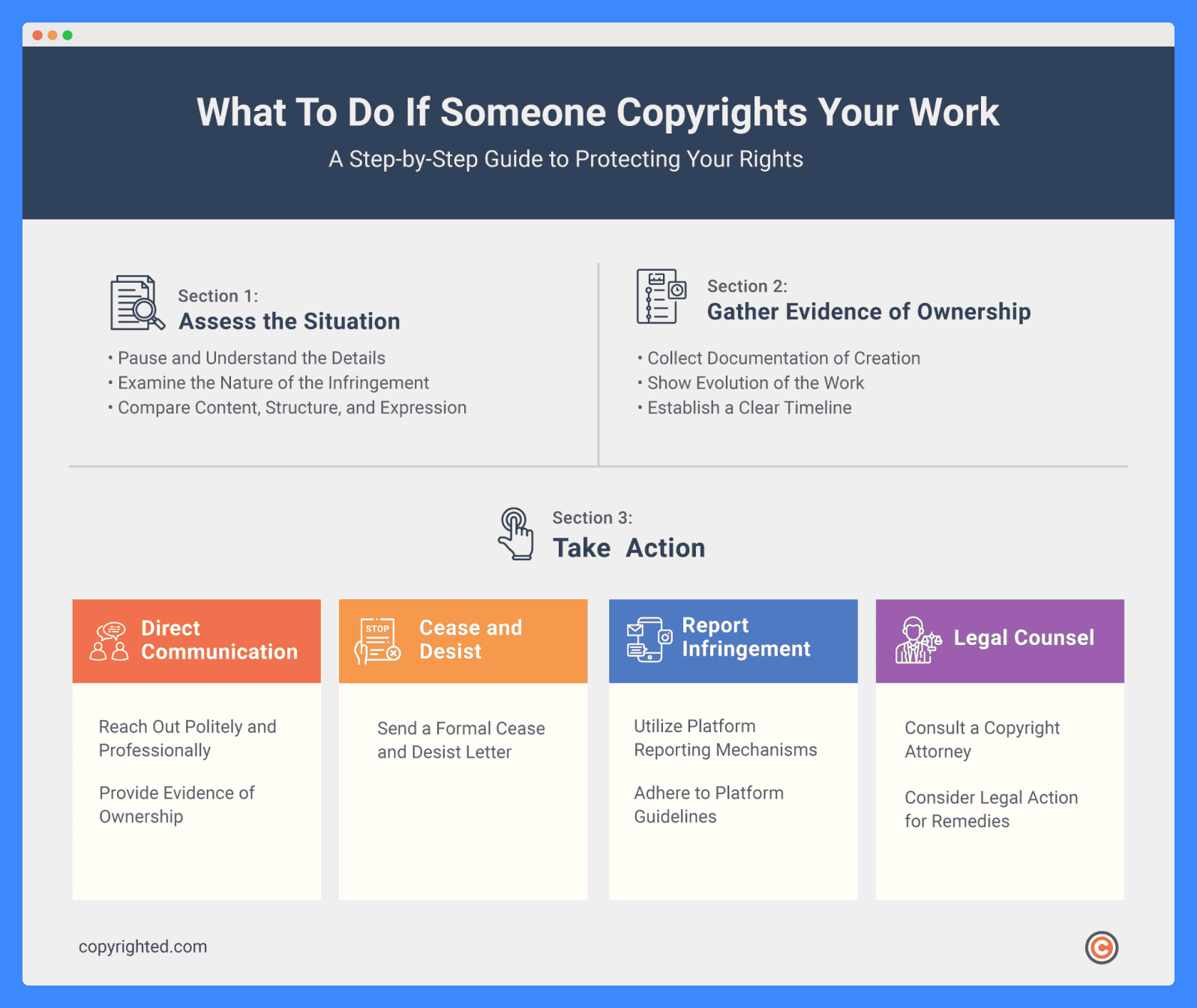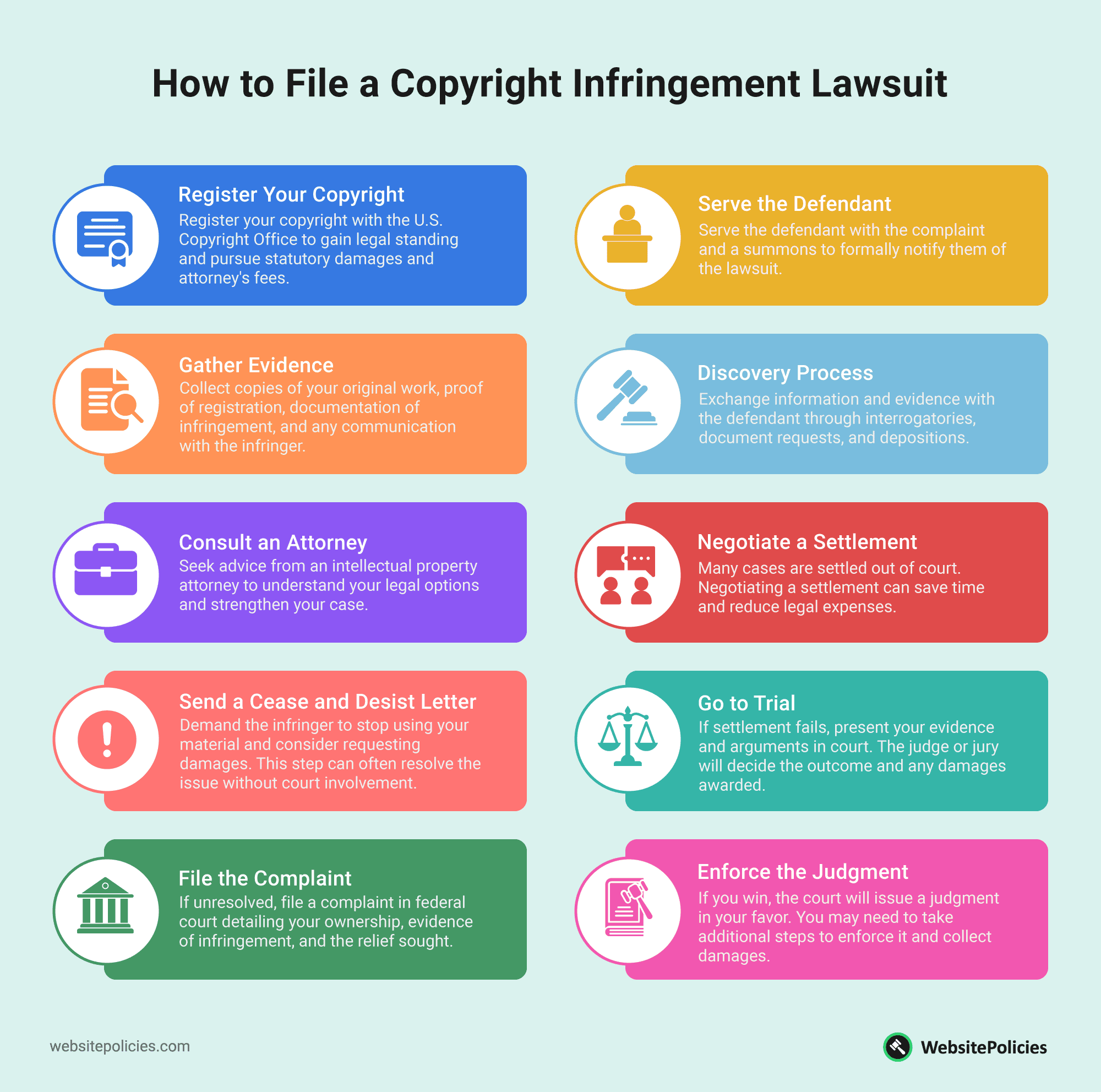When multiple people create something together, who owns the copyright? It’s a question that comes up more often than you might think.
It doesn’t matter if you’re a musician working on a song, a writer collaborating on a screenplay, or entrepreneurs developing software together; understanding joint copyright ownership is crucial for protecting your creative rights.
The reality is that joint copyright ownership is more complex than many creators realize. The concept seems straightforward; it’s when multiple people share ownership of a copyrighted work. But it’s actually quite tricky to implement and comes with unique challenges.
Today, we’re going to break down everything you need to know about joint copyright ownership. We’ll show you how it works, look at common scenarios where it applies, and, most importantly, talk about issues that may pop up, as well as actionable solutions.
Let’s dive in!
Table of Contents
Understanding Joint Copyright Ownership
Put simply, joint copyright ownership happens when two or more people share ownership rights to the same creative work.
It’s so integral to the law in the U.S that it’s mentioned in the very first part of the Copyright Ownership handbook:

The law recognizes joint copyright ownership when multiple creators contribute to a work with the intention of merging their contributions into a single piece. This includes multiple copyright categories, including a song written by multiple songwriters and photographs taken by two photographers working together.
Joint copyright ownership is different from other types of ownership because each owner has equal rights to use and license the work. In other words, a joint owner can use the work or grant non-exclusive licenses to others, though they are usually required to share any profits with their co-owners.
But here’s where things get interesting – and sometimes complicated. Just because you worked on something with someone else doesn’t automatically mean you’re a joint copyright owner. The contribution needs to be original and creative. For example, simply giving feedback on someone’s written work probably won’t make you a joint copyright owner, but actually writing portions of the text might.
This is why it’s so important to understand exactly what joint copyright ownership means before you start collaborating with others. The decisions you make at the beginning of a project can have huge implications down the road.
Common Scenarios for Joint Copyright Ownership
Before we get into specific scenarios, it’s worth noting that joint copyright ownership can happen in almost any creative field. However, some situations are more common than others, and understanding these can help you find the best situation for your needs.
Musical Collaborations
The most common time you’ll see joint ownership is when musicians work together to create songs. Typically, this happens when multiple people contribute to the melody, lyrics, or arrangement of a piece.
For example, if one person writes the lyrics while another composes the melody, they both have claims to copyright ownership of the final song.
Literary Works and Publications
Joint ownership often occurs in writing, especially with co-authored books, academic papers, or screenplays. When two or more writers actively contribute to the content creation, they share ownership of the final work.
This is quite different from an editor’s role, which typically doesn’t qualify for copyright ownership.
Software Development
In tech, specifically digital products like software, joint copyright ownership is the norm. This is particularly common in startup environments where several programmers might work together to create a new application or product.
Artistic Collaborations
Visual artists often work together, which leads to joint ownership situations. This could involve photographers working on a virtual gallery together, artists collaborating on a mural, or designers creating a brand identity as a team.
Business Partnerships
When business partners create intellectual property together, joint copyright ownership often comes into play. This might happen when partners develop training materials, marketing content, or other creative assets for their business.
Or for example, if a consultancy is developing an employee feedback system, partners might collaborate on content, assessments, or reports—like in a 360 review process—where shared contributions lead to shared ownership of the intellectual property.
Inherited Rights
Sometimes, joint copyright ownership occurs not through creation but through inheritance. When a copyright holder passes away, their rights might be divided among multiple heirs; this often creates a joint ownership situation.

Rights and Responsibilities of Joint Copyright Owners
It’s important to understand that joint copyright ownership comes with both privileges and obligations. These are some of the things you’ll want to keep in mind if you plan on becoming a joint copyright owner:
- Equal Rights – Each owner can use, license, and profit from the work. You don’t need permission from other founders to do any of this since everyone has the same rights.
- Duty to Share Profits – However, when you make money from a joint project, you’re required to share it with your co-owners. This means keeping accurate records and tracking your income.
- Non-Exclusive Licensing – Anyone with the copyright can grant non-exclusive licenses to others without getting permission from co-owners. However, exclusive licenses typically require everyone to be on board.
- Right to Transfer Ownership – Each owner can sell or transfer their share of the copyright to someone else, though this often requires notifying other owners.
- Obligation to Cooperate – Owners must work together reasonably when it comes to major decisions about the work’s use and exploitation.
- Right to Sue for Infringement – Any owner can take legal action to protect the work from copyright infringement, though it’s usually best to involve all owners in such decisions.
7 Critical Issues in Joint Copyright Ownership
Joint copyright ownership comes with several common issues that can create problems if not handled properly. Understanding these copyright challenges and knowing how to address them will help you protect your rights and maintain positive working relationships.
Revenue Sharing Disputes
Money issues often create the biggest problems in joint ownership situations. Without clear agreements, owners frequently disagree about the fair distribution of profits, especially when different people contribute different amounts of work.
These disputes can become particularly heated when the work unexpectedly becomes successful or generates significant income.
The solution is creating a written agreement upfront that clearly states how revenue will be split. This should include details about different types of income (licensing, royalties, sales) and how they’ll be divided.
Having this structure in place before money comes in prevents conflicts and protects everyone involved.
Decision-Making Deadlocks
Joint owners frequently run into problems when they can’t agree on how to use or license their work. When owners have different goals or visions for what they worked on together, this can become challenging.
For instance, one owner might want to license the work exclusively to a major company, while another is more interested in broad distribution rights. These deadlocks can slow down progress and prevent the work from reaching its full potential.
Much like our first issue, the best way to handle this is to establish a clear decision-making process in writing. Your agreement should specify which decisions need unanimous agreement and which can be made individually.
Including a dispute resolution process, like mediation, gives you a clear path forward when disagreements arise. Many successful joint ownership agreements also include timeframes for making decisions and fallback procedures when owners can’t reach a consensus.
Here’s a great example that can align owners if they are wondering what to do if someone copyrights their work:

Attribution Conflicts
Attribution disputes are especially common in creative fields where recognition matters as much as money. These conflicts typically arise over how credit should be given or how the work should be shown to the public.
Social media has made this even more complicated, as work can be shared and credited in many different ways. When you consider that over 5.22 billion people use social media, it’s not hard to imagine how this could lead to issues.
You’ll want to figure out everyone’s roles and contributions early on and agree on how their credit will appear. This includes everything from promotional materials to legal registrations.
Smart joint owners also establish guidelines for social media posting, public announcements, and press releases to ensure consistent attribution across all platforms.
Licensing and Usage Rights
The ability of each owner to independently license the work sometimes leads to conflicts.
This could lead to issues like an owner granting a license that conflicts with another owner’s plans or values.
This is a big problem when dealing with non-exclusive licenses, where multiple owners might unknowingly license the work to competing businesses or platforms. For example, if two photographers own the content within a photo gallery, one might want to give the photos to a company to use for their marketing, whereas the other one might want to add some to a stock photo site so they can make residual income.
Beyond just potential conflicts, there’s also the challenge of tracking who has licensed the work and under what terms. Without proper communication between owners, it’s easy to lose track of how the work is being used and whether all parties are receiving their fair share of licensing revenues.
The solution is tracking who has a license, what type it is, and how long it is expected to last. All owners should agree to document and share information about any licenses they grant. When you have a centralized place for managing how people can use the work, it helps to prevent overlap and ensures transparent record-keeping.
Registration and Documentation
Many joint owners run into problems when it comes to officially registering their copyrights. The registration process requires detailed information about ownership percentages, creation dates, and contribution levels that might not have been clearly established in the early days of the project.
These issues become even more complex when dealing with international copyright registration or when the work spans multiple copyright categories. Sometimes, owners discover they have different interpretations of their ownership rights only when trying to complete registration paperwork.
The fix is documenting everything from day one. Keep records of who contributed what and when, maintain copies of all drafts and versions, and save any correspondence about ownership discussions. Having these records available makes it easier to register and can help if there are any disputes.
Enforcement Challenges
Taking legal action against infringement can be tricky if multiple owners are involved. There may be questions like who should pay for legal proceedings, who makes decisions about settlements, and how to divide any recovery.
In extreme situations, one owner might want to pursue legal action against someone or a business, while others prefer to handle the situation differently. As you can see, that process can get quite complicated.

There’s also the practical challenge of coordinating between multiple owners when legal issues come up. If each person has different priorities or goals, it can make it hard to get these issues resolved quickly and painlessly.
The best approach in this situation is to establish rules around this in advance. Your initial agreement should outline how decisions about legal action will be made, how costs will be shared, and how any recoveries will be distributed.
Including provisions for alternative dispute resolution can also help manage enforcement costs.
Transfer and Succession Issues
Problems often emerge when one owner wants to sell their share or when ownership transfers through inheritance. Without clear guidelines, remaining owners might find themselves dealing with new co-owners who have different values or goals for the work.
This situation becomes especially complicated in situations involving divorce, bankruptcy, or when a business dissolves. Questions about whether rights can be transferred, who has the first right of refusal, and how to value ownership shares often lead to disputes.
The solution is to include detailed transfer provisions in your initial agreement. Specify whether owners have the right to transfer their shares, what approval process is required, and how ownership shares should be valued. It’s also wise to include plans in the event of a death or business dissolution.
Best Practices for Managing Joint Copyright Ownership
After looking at all these potential issues, you might be wondering how to best protect yourself and your work. Here are a few best practices, some we mentioned, some we didn’t, that can help you with your next joint ownership venture:
- Come up with Clear Contracts – Don’t rely on verbal agreements or assumptions. Create a comprehensive written agreement that covers ownership percentages, decision-making processes, and profit sharing. You should do this before you start working together or as early as possible in the collaboration.
- Set Up Communication Protocols – Regular check-ins with all owners are crucial so you all can discuss important decisions, review financial reports, and address any concerns. Having an established communication system prevents misunderstandings and keeps everyone informed.
- Keep Detailed Records – Don’t forget to keep records of all income, expenses, and licensing agreements. Use dedicated accounts for joint copyright revenues and maintain transparent reporting systems that all owners can access.
- Have a Clear Decision-Making Process – Establish which decisions need unanimous agreement and which can be made individually. Include deadlines for responses and procedures for breaking deadlocks in the event that everyone can’t agree.
- Establish an Exit Strategy – Think ahead about how ownership changes will be handled in the event someone decides to give up their ownership or passes away. Include provisions for selling shares, succession rights, and first right of refusal for existing owners.
Final Thoughts
Understanding joint copyright ownership is crucial for anyone working on creative projects with others. While it might seem simple on the surface, the reality is that joint ownership comes with unique challenges that you’ll need to consider.
The most important lesson to take away from this is it’s much easier to establish all of these things as early as possible. You don’t want to be in a situation where the success of your product dictates the contract instead of the other way around.
The truth is, no one likes to think about potential problems when starting an exciting creative project. But preparing now can save you from major headaches down the road. By understanding these joint copyright ownership issues and how to fix them, you can spend less time stressing and more time focusing on creating great work together.


